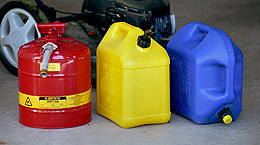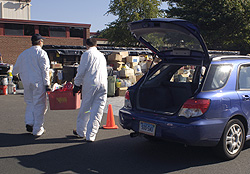|
What defines a hazardous
material? A hazardous material is any material that
possesses an unreasonable risk to the health and safety of
person and/or the environment if it is not properly controlled
during handling, storage, manufacture, processing, packaging,
use, disposal or transportation.
Hazardous materials are
everywhere, as they are not just found in commercial and
industrial establishments. The average home usually contains
several items that can be categorized as a hazardous material.
Here are but a few examples:
![bullet]() |
Fuels such as gasoline,
kerosene, camping fuel and propane
|
|
|
Pesticides, herbicides
and fertilizers
|
|
|
Thinners, solvents,
stains, varnishes and
paint
|
|
|
Swimming pool sanitizers
which contain chlorine and chlorine
derivatives
|
|
|
Factory-loaded
ammunition & ammunition reloading powders
|
|
|
Cans of flammable
aerosols
|
|
|
Photographic darkroom
chemicals
|
Even though there are many
dangerous substances out there, for the most part they are
widely and safely used on a daily basis for a myriad of
applications. Problems arise when these substances are
handled, stored and disposed of without the respect they
should be given, and unintentional releases occur as a
result.
As we stated, there are
numerous hazardous materials and several are available for use
by the general public. It would be impossible to provide you
with guidelines for individual products, or even classes of
products. However, one rule always applies to all hazardous
materials:
ALWAYS
FOLLOW THE MANUFACTURER'S INSTRUCTIONS COMPLETELY FOR
HANDLING, STORING, APPLYING AND DISPOSING OF THE
PRODUCT.
Notwithstanding, there are two
areas of concern regarding some of the more common hazardous
materials that can be found in the home, in which we may
possibly help to educate you further. They are storage and
Storage
There
are several measures that you can take to help reduce the risk
when storing hazardous materials at your residence. We must
once again reiterate that first
and foremost:
the safest way to store a
hazardous material is in the manner which is prescribed by the
manufacturer.
Try
to limit the amount of a substance you have on-hand. In this
age of warehouse clubs and super-stores, many items can be
bought in large quantities, maybe larger than what you may
need. The more of a hazardous substance that you have on-hand,
the more of a hazard it becomes. If the material has expired,
or you no longer need it, dispose of it
properly.
 |
|
Is there a potentially toxic concoction
brewing in your garage, shed or
basement?
|
|
Segregate
hazardous materials from each other appropriately, and
segregate them from other items that could help compound an
already dangerous situation. Let's look at a few common
substances that are found in the home.
Many
swimming pool treatment products contain chlorine, or a
chlorine derivative. Chlorine is an oxidizer. In the event of
a fire, chlorine could provide a source of oxygen and
exacerbate a fire. Therefore it would not be wise to store
your pool treatments next to the five gallon can of
gasoline.
Gasoline
is another substance that is commonly found in the home and
that we are very familiar with. It readily gives off vapors,
is extremely flammable and is an explosion hazard. Storing
gasoline, or any type of flammable liquid, next to that pile
of newspapers and cardboard you keep meaning to recycle is not
a good idea.
If
possible, segregate hazardous materials from your home
completely. Garages and basements are often the location where
we store many of these types of materials. Try not to store
these products in your home if possible. A detached shed away
from your home is a good alternative, although one must be
careful not to create another hazard by moving the gasoline,
chlorine and fertilizer all out to the shed for storage. If
you must store these products inside the home, remember to use
the proper containers for each substance.
Take
much care when storing flammable liquids inside the home as it
is highly advisable that the home owner refrain from doing so.
There have been many cases of vapors from flammable liquids
stored inside a residence finding their way to ignition
sources, such as a water heater that uses natural gas or
propane, and starting a fire that now has an optimal fuel
source. The home owner must consider and identify any possible
ignition sources when storing flammable liquids, whether it is
inside the home or not.
|

|
|
|
Flammable
liquid and aerosol safety
cabinets
|
Another
storage precaution that can be taken is the use of a safety
cabinet to help segregate and secure hazardous materials such
as flammables, combustibles, corrosives, pesticides,
herbicides and fertilizers. These cabinets generally have many
safety features such as sumps to catch spills, self-closing
doors or doors that will automatically close in fire
conditions, handle locks for security, and insulation to
provide fire resistance.
Hazardous
materials can react with, damage and breach an improper
container. Not all metals and synthetic containers are the
same. While a hazardous material might be safely stored in one
type of metal or synthetic container, they might not be stored
safely in a different type of metal or synthetic container.
Also, a material that is stored safely in a metal container
might not be store safely in a synthetic one, and vice versa.
While glass may be a good container for some materials, it is
fragile. Again, not all containers are the same, so if a
manufacturer uses glass to house a hazardous material, it is
best to keep it in its original container, and treat it with
extra care.
|

|
|
Approved
containers for flammable liquids made from metal and
synthetic materials. Different colors signify different
types of flammables, such as gasoline, diesel and
kerosene.
|
|
Storing
hazardous materials in their proper container is probably the
most important thing you can do to help effectively limit the
hazard, after eliminating the material from your home
completely. If you must store the substance in a container
other than the original packaging, make sure you use a
container that is specifically designed and recommended for
use with that substance.
One
last important point regarding storage is to make sure all
hazardous materials are properly labeled and identifiable.
This is especially important if you use a container other than
the original. Accidents happen when containers are not
labeled, mislabeled, or used for substances other than what
they are labeled for. For instance, a commercial fisherman was
injured when he went to add what he thought was water to his
boat's radiator but instead poured gasoline. Several similar,
unmarked containers were sitting together and his mate handed
him the wrong container. The resulting explosion knocked the
fisherman overboard and burned his upper body. Think what
could happen if someone went to add kerosene to a portable
heater but the container had old gasoline in it instead of
kerosene. The results could be deadly.
|

|
|
|
DOT placard and NFPA diamond
|
Although
never meant for public use, two systems of identifying
hazardous materials in industry are becoming increasingly more
visible to the general public. They are the Department of
Transportation's Hazardous Materials Warning Placard System
and the
National Fire Protection Association's 704
Diamond. The DOT HazMat placards were instituted as a way
of helping to identify classes of materials during shipment,
specifically from a distance in an emergency situation. The
NFPA diamond is sometimes used where hazardous materials are
stored and used, and is intended to signify their presence,
and give a general indication to the degree of severity for
health, flammability and reactivity.
For
the general public, these symbols are of little value other
than alerting those familiar with them that the substance or
container which they are marking is a hazardous material and
should be treated with appropriate care.
In
summary, here are the key points to storing hazardous
materials at your home:
-
Always
follow the manufacturer's instructions regarding the
storage of a hazardous material.
-
Limit
the amount of material you have on-hand, and properly
dispose of it when you no longer need it.
-
Segregate
materials appropriately and to the best of your ability,
including storing them away from the home.
-
Store
materials in the proper containers and make sure they
are appropriately
labeled.
Disposel
It
is not uncommon for the average home owner to have the need to
dispose of common household hazardous materials (also known as
household hazardous wastes) such as paint, batteries, oil and
gasoline, just to name a few. When materials such as these are
no longer needed, or have expired because of use or time, it
is a wise decision to remove them from the
home.
For
the most part, the general public has become educated as to
the risks associated with improper disposal of hazardous
materials. The days of dumping the old motor oil from the oil
change down the sewer drain have for the most part come to an
end, thanks largely in part to environmental awareness
education. However, the result from this increased public
awareness, along with more stringent laws and enforcement, has
commonly led to the public accumulating these unwanted
materials in their homes instead of disposing with them.
Sometimes they accumulate to very dangerous
levels.
The
common belief is that these materials are to difficult to
dispose of properly, and/or too costly to do so. This is a
misconception. While it may not be as easy as placing them out
with the regular garbage collection, or as cheap, it is not as
difficult or costly as one might think. We must once again
reiterate that:
the
safest way to Dispose of a hazardous material is in the manner
which is prescribed by the manufacturer.
The
second manner for disposing of your unwanted materials is to
contact your solid waste removal provider, whether it be a
governmental service, or a private company. If they can not
help, try your local environmental protection department for
guidance.
Ask
them about how to properly dispose of your specific materials.
You may not be able to dispose of all your materials in the
same manner. For instance, motor oil might have to be taken to
a gas station, road flares given to the fire department, and
the old air conditioner taken to the public works department.
It all depends upon the material, and the local regulations in
your area. Disposal fees might also be associated with some
items.
 |
|
Personnel will generally remove your items
from the vehicle while you wait safely inside. Know what
materials may be disposed of at a collection site and
how to do so properly.
|
|
Many
municipalities, county and state governments sponsor hazardous
waste collection days where the general public may bring
certain items for drop-off and disposal. Not all materials may
be eligible for disposal at these events, and there are rules
and laws regarding the transporting of these materials to the
drop-off site. Please be sure that you understand what
materials are eligible for disposal and how to properly
transport and drop-off these items before attempting to do
so.
Contact your town
government or state environmental protection agency and
inquire about household hazardous waste collection programs.
If
there are no collection programs in your area, or you are
having difficulty finding someone to accept your materials,
try contacting a private environmental services company as
they sometimes will privately contract with you to remove your
unwanted materials, but remember, some fees might
apply.
Learn More
General
U.S. Environmental Protection
Agency
Household Hazardous Waste
page
Storage
National Fire Protection
Association
Safety Fact Sheets on Gasoline and Propane
Safety
Disposal
Connecticut Department of
Environmental Protection
Household Hazardous Waste page
Connecticut
Department of Environmental Protection
Household Hazardous Waste Collection
Schedule
|
